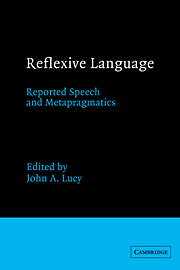Book contents
- Frontmatter
- Contents
- Acknowledgments
- General introduction
- Part I Theoretical foundations
- Part II The relation of form and function in reflexive language
- Introduction to Part II
- 3 The boundaries of reported speech in narrative discourse: some developmental aspects
- 4 Metapragmatic presentationals: reporting speech with quotatives in Yucatec Maya
- 5 Metalanguage and pragmatics of deixis
- 6 Learning what to ask: metapragmatic factors and methodological reification
- Part III Text, context, and the cultural functions of reflexive language
- Part IV Interpretation, reported speech, and metapragmatics in the Western tradition
- Name index
- Subject index
3 - The boundaries of reported speech in narrative discourse: some developmental aspects
from Part II - The relation of form and function in reflexive language
Published online by Cambridge University Press: 22 January 2010
- Frontmatter
- Contents
- Acknowledgments
- General introduction
- Part I Theoretical foundations
- Part II The relation of form and function in reflexive language
- Introduction to Part II
- 3 The boundaries of reported speech in narrative discourse: some developmental aspects
- 4 Metapragmatic presentationals: reporting speech with quotatives in Yucatec Maya
- 5 Metalanguage and pragmatics of deixis
- 6 Learning what to ask: metapragmatic factors and methodological reification
- Part III Text, context, and the cultural functions of reflexive language
- Part IV Interpretation, reported speech, and metapragmatics in the Western tradition
- Name index
- Subject index
Summary
Introduction
Speech can be reported in a variety of more or less explicit ways. The most obvious types of utterances reporting speech contain verbs of saying that refer explicitly to speech events and present this speech in direct and indirect quotations. Such metalinguistic utterances all mark explicitly some boundary between the reported message and the narrator's message, although they differ in other ways. Other types of utterances can also be used to present speech events in less obvious ways that do not explicitly represent speech qua speech. By virtue of their form and content in isolation, these utterances do not, strictly speaking, quote speech. When they are embedded in discourse, however, they constitute nonexplicit ways of reporting speech, the uses of which are systematic from a functional point of view.
The study presented below examines the different utterance types that were used by (English-speaking) adults and 4- to 10-year-old children when reporting dialogues in various situations. Several discourse modes are identified in the corpus and variations in their uses are illustrated in two types of narrative patterns: (1) prototypical cases, namely when dialogues were reported entirely in one mode, and (2) mode mixtures, namely cases which involved more than one mode.
- Type
- Chapter
- Information
- Reflexive LanguageReported Speech and Metapragmatics, pp. 63 - 90Publisher: Cambridge University PressPrint publication year: 1993
- 39
- Cited by



